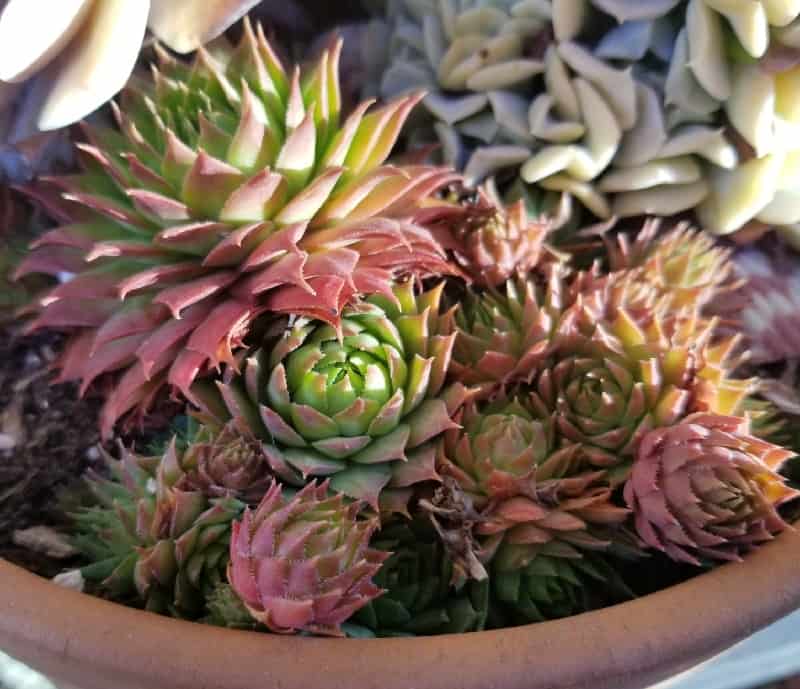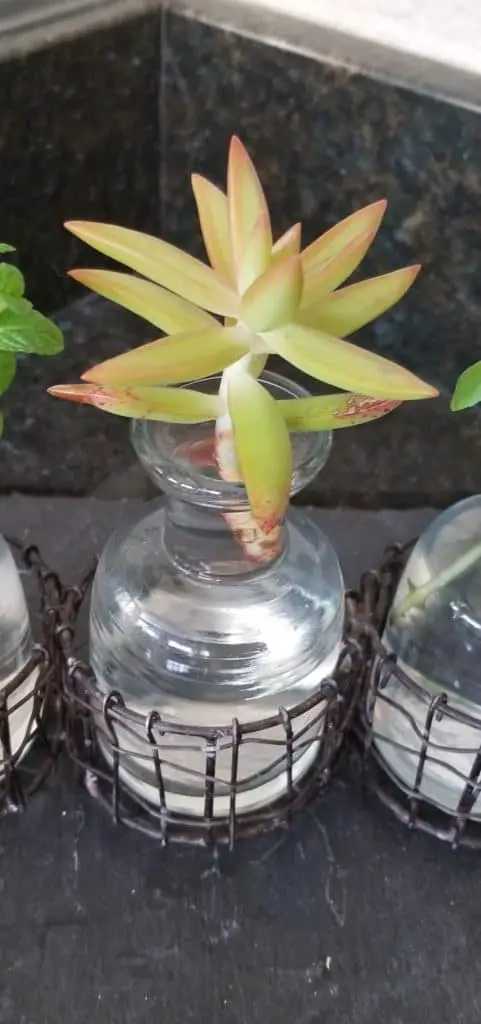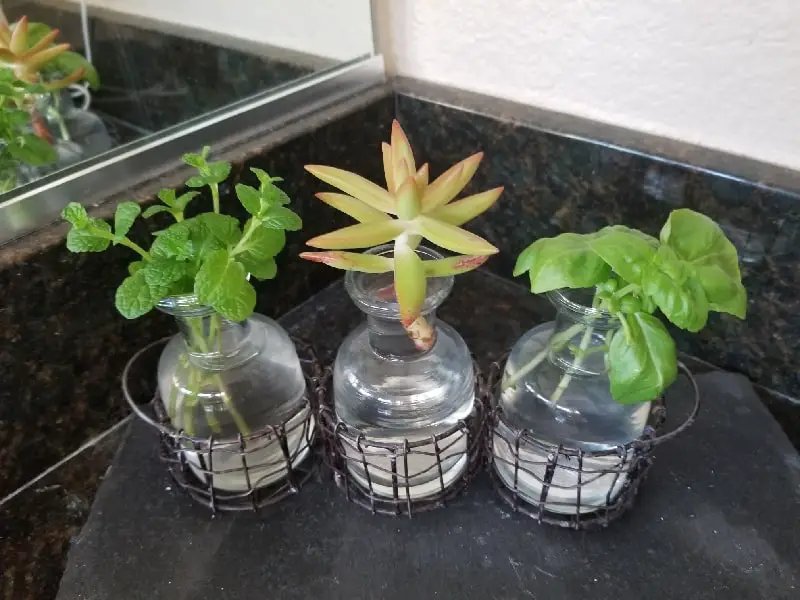It seems like growing houseplants hydroponically is becoming more and more popular. I have been seeing hydroponic systems all over my Instagram feed, and I can’t blame people for their enthusiasm. Hydroponics is a versatile way to grow plants and is great for people who are looking for a less messy alternative to soil-based growing. But can you grow succulents hydroponically?
It may seem counterintuitive, but succulents can grow hydroponically. However, succulents typically require a weaker nutrient solution than other plants that are grown hydroponically.
In this article, I will give you the information you need to start growing your succulents hydroponically!
What is Hydroponics?
Hydroponics is the practice of growing plants in a soilless medium. You may have seen people on Instagram growing plants in “cocoa puffs.” That is a passive hydroponic system growing in expanded clay pebbles.
There are a variety of ways to grow succulents hydroponically. Passive hydroponics, also called semi-hydroponics, is a system that does not include pumps or any other way of circulating the nutrient solution. In contrast, active hydroponics relies on a pump to deliver nutrients to the plants. Luckily, succulents do not need to grow in an active hydroponic system. Therefore, we will be discussing passive hydroponics in this article.
The benefits of hydroponics are that you do not have to deal with the mess associated with soil and plants actually tend to grow more quickly in hydroponic settings. Growing succulents hydroponically is also a low-maintenance way to enjoy succulents. Finally, growing hydroponically is usually associated with fewer pest problems.
Why Succulent Roots Won’t Rot in Water
If you have been a succulent owner for a while, you know that it is absolutely essential not to overwater your succulents or the roots will rot. This may lead one to believe that succulents will be prone to root rot when they are sitting in water. However, this is not the case.
Succulents are prone to root rot in wet soil because the anaerobic conditions present in wet soil promote pathogen and fungal growth. It is the fungus and bacterial pathogens that are responsible for root rot, not the water itself. Therefore, succulents do not have an issue growing hydroponically.
This does not mean that hydroponic systems are completely immune to fungal growth that may cause root rot. It is important to ensure that your systems are clean and that you change the water in your hydroponic system regularly.
Best Succulent Species for Hydroponics
I would recommend starting your hydroponics journey with succulents that can be easily propagated from leaf or stem cuttings. This will ensure that you do not lose an entire plant if something goes wrong. Here are a few species I suggest for hydroponics:
Graptopetalum paraguayense (Ghost Plant)
This succulent seems to grow really fast, and I have had good luck propagating it. Keep in mind that this species requires a sunny spot to thrive.

Graptosedum California Sunset
If you want to maintain that awesome deep red color, it is important to keep this plant in an area where it will be exposed to a lot of bright sunshine.

Sempervivum
This variety, which includes several types of succulents, grows like crazy, and the rosette structure is very attractive. They are also a hearty type of succulent that can stand cold temperatures and even snow!

Procedure for Growing Succulents Hydroponically
The procedure described below lists the steps for planting a succulent hydroponically. These steps assume that you are using a succulent cutting. If you want to use a whole plant, simply rinse all of the dirt off of the roots of the succulent between steps 2 and 3.
What You Will Need
- Net Pot (preferably 3-inch) or inner pot with holes (e.g., a nursery pot)
- Mason Jar (wide mouth if using 3-inch net pots) or outer pot without drainage holes that will act as a reservoir
- Lightweight Expandable Clay Aggregate (LECA)
- Hydroponic nutrients (I recommend using the General Hydroponics Flora Series)
- Scissors or gardening shears
- pH Meter
- pH Up and pH Down
- Rooting Hormone
Note: If possible, your outer pot should be opaque. This will prevent algae growth. I like to use the amber mason jars for “mason jar hydroponics.” Although they are not completely opaque, I have not had any issues with algae growth. IKEA has a lot of good hydroponics supplies at an affordable price.
Step 1: Prepare the Succulent Cutting
Use your scissors or gardening shears to snip a stem cutting from a succulent cutting. Make sure you have sanitized your scissors with alcohol so you do not spread any diseases to your plant.
Then let the cuttings dry for a day or two. It is important to let the end of your succulent scab over before putting it in water. If you do not let the end scab over, the succulent will absorb too much water.
After you let the cutting dry out, dip the end of the cutting in rooting hormone.
Finally, place the cutting in a jar or vase filled with water and place your succulent cutting in a bright spot. It will take 2-4 weeks for the succulent to form roots. I recommend changing the water every couple of days.

Step 2: Soak and Rinse the LECA
Lightweight Expanded Clay Aggregate (LECA) are clay pellets that have been heated and tumbled in a rotary kiln. They are chemically inert meaning that they will not deliver any nutrients to your plants. LECA holds water and hydrates the plant’s roots.
It is important to rinse off the LECA balls because they contain dust particles and other contaminants. If you are re-using LECA, it is especially important to clean them because LECA will hold on to nutrients and salt will build up over time.
- Put your LECA in a bucket.
- Then fill the bucket with water and swirl the LECA balls around.
- Drain the now dirty water and fill the bucket with clean water.
- Let the LECA soak for 12-24 hours.
- When it is time to plant your succulent, rinse the LECA using a colander.
Step 3: Plant the Succulent
Fill your net pot or inner pot about 1/3 of the way with the clean LECA pellets. Place your succulent in the pot and place more LECA pellets around it.
Step 4: Add the Nutrient Solution
Succulents will require nutrients in order to continue growing and thriving in a hydroponic system. Unlike traditional soil growing, hydroponic substrates do not hold nutrients. Therefore, you will have to add nutrients to the water in your system.
In general, succulents need weaker nutrient solutions that other plants that are grown hydroponically. If you use a nutrient solution that is too strong, you can burn your succulents.
I would recommend using the General Hydroponics Flora Series nutrients to feed your succulents. Keep in mind that the guidelines provided on the labels are written for people growing vegetables. Succulents (and other houseplants) require a much lower concentration of nutrients.
If you have hard water (a TDS above 250 ppm), consider using FloraMicro Hardwater. To use FloraMicro, add 1/4 tsp to 1 gallon of water (filtered tap water or distilled water) and mix. Otherwise, add 1/4 tsp of FloraGro to 1 gallon of water and mix.
I recommend using FloGro because it contains nitrogen, phosphorus, and potassium. Please keep in mind that this nutrient mixture is conservatively weak. If your succulents start to show signs of nutrient deficiencies in the future, consider adding more nutrient to your mixture.
Note: Your succulent cuttings do not need to be in the nutrient solution until roots start growing. So do not worry about mixing nutrient solutions when your succulents are initially propagating succulents.
Step 5: Check the pH of your Nutrient Solution
Once you have prepared your nutrient solution, it is important to verify that the pH is within an appropriate range. The pH of your water should be between 5.5 and 6.5. When the pH is outside of this range, the plant cannot uptake nutrients very well.
Use a pH meter to measure the pH of your water. Make sure you calibrate the pH meter per the manufacturer’s instructions before use.
If your pH is outside of the acceptable range, add pH Up or pH Down to adjust the pH accordingly (follow the instructions on the product labels).
Step 6: Add the Nutrient Solution to the Reservoir
The reservoir is your outer pot or a mason jar.
Place the inner pot with the planted succulent (or net pot) into the outer pot (or mason jar). Pour the nutrient solution into the outer pot until the water line is about 1/3 of the height of the inner pot.
Step 7: Maintain the Water Level
Every week or so, you may notice the water level in your reservoir has gone down. Top off the reservoir with pH-adjusted water (filtered water or distilled water). It is important to keep the reservoir about 1/3 of the way full. Otherwise, the LECA may dry out and lose its ability to “wick” water for the plant.
Do NOT add more nutrient solution at this stage. If you add more nutrient solution, the concentration of salts in the solution will increase significantly and adversely affect the pH.
Step 8: Flush the System
Every month or so, it is a good idea to flush your hydroponic system. This is particularly important if your LECA has some salt buildup on it. Simply take your inner pot out of the outer pot and hold it under some running water.
Then rinse out your outer pot and add some fresh nutrient solution.
Step 9: Enjoy!
Enjoy your succulent! Simply repeat steps 7 and 8 to keep your plant happy and healthy.
Related Questions
Can succulents with woody stems be propagated in water?
Yes, succulents with woody stems can be propagated in water. For example, water propagation works for jade plants (crassula ovata) and for blushing beauty plants (aeonium).

